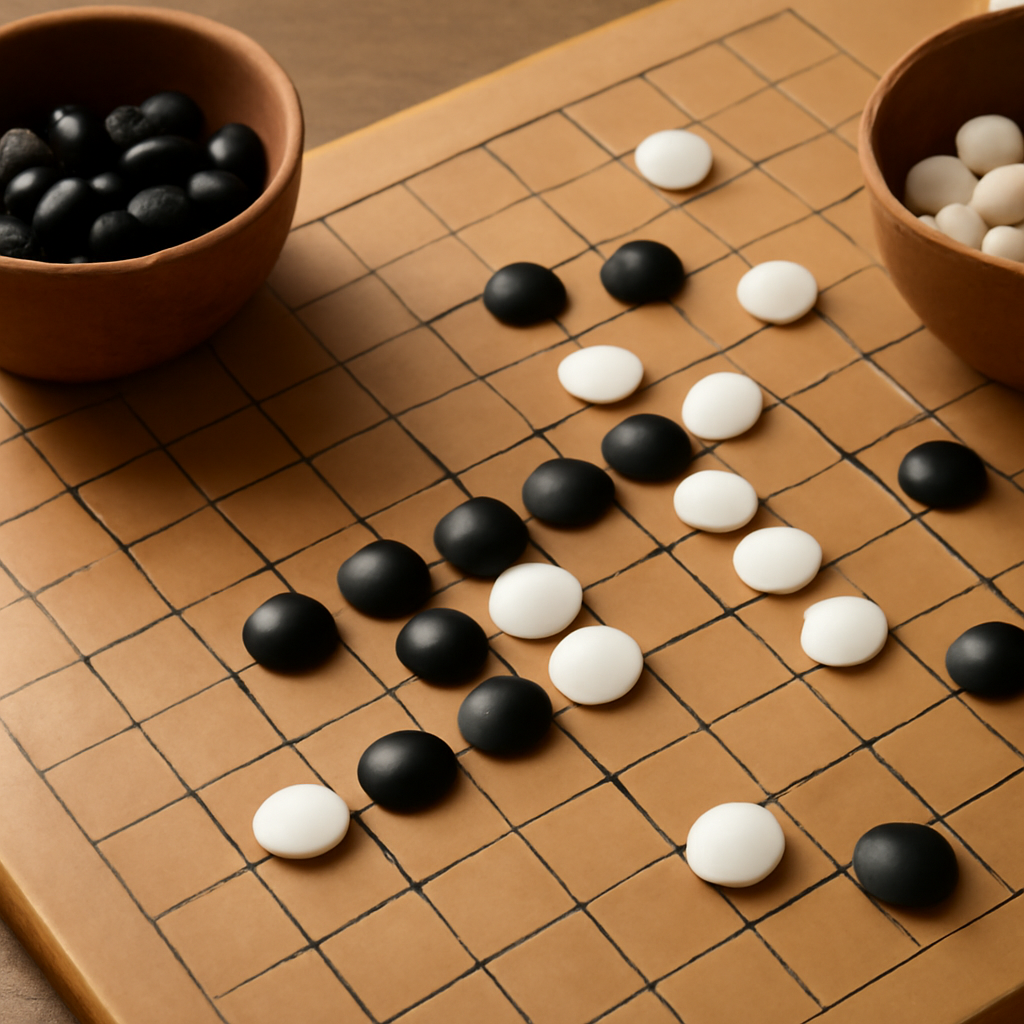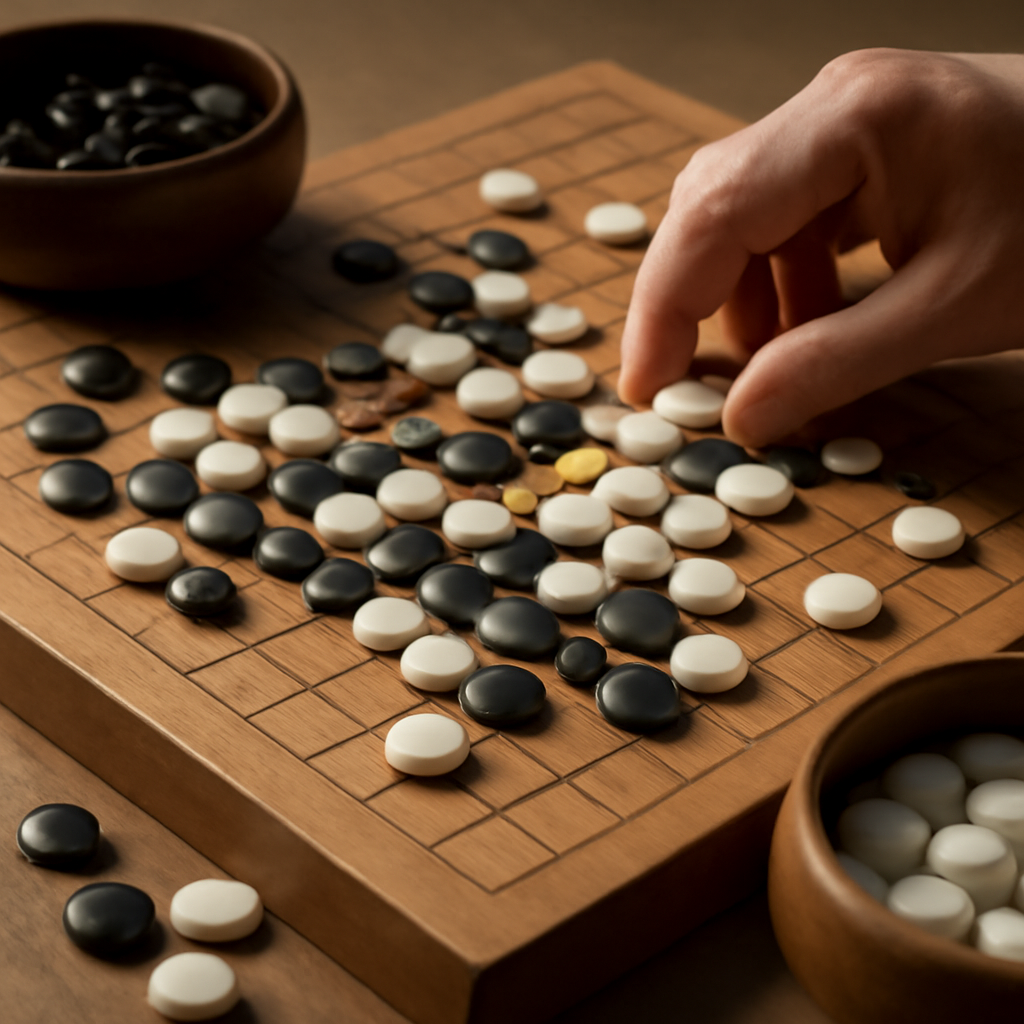Key Takeaways
- Gomoku is a strategic placement game focusing on connecting five stones in a row on a grid, with straightforward rules but complex tactics.
- Go centers around territorial control using black and white stones on a large board, with an emphasis on capturing and life-death situations.
- Differences in complexity levels make Gomoku easier to learn initially, but Go offers deeper strategic possibilities that can take years to master.
- The game dynamics, scoring, and gameplay pace vary greatly, with Gomoku being faster and more accessible, whereas Go involves prolonged planning and calculation.
- Both games have rich cultural backgrounds, influencing regions and communities, but their gameplay philosophies differ significantly.
What is Gomoku?

Gomoku, also called Five in a Row, is a strategy game played on a grid where players alternately place stones aiming to line up five of their own in a row. It has origins dating back over a century, with variations existing across different countries. Although incomplete. The game’s rules are simple, making it easy to learn, but mastering it requires anticipating opponent strategies and pattern recognition.
Simple rules, deep tactics
Gomoku’s fundamental rule is that players take turns placing stones on empty intersections of a grid, with the goal to connect five consecutively. Despite this simplicity, advanced tactics involve creating multiple threats simultaneously, forcing the opponent into defensive moves. Recognizing patterns like open fours or double threats is crucial for winning. The game’s straightforward mechanics make it accessible for beginners, but developing skill involves understanding complex move sequences.
In competitive contexts, Gomoku often includes restrictions like “overline” or “double-three” rules to prevent trivial wins, adding layers of strategic depth. Although incomplete. Although incomplete. These constraints push players to think more creatively about their placements. For example, blocking an opponent’s double-three can be just as important as creating your own winning line. The balance between offense and defense is central to high-level play, requiring both foresight and adaptability.
The game’s flow is fast, with most matches lasting only a few minutes to half an hour, making it suitable for quick matches or casual play. Despite its simplicity, tournaments feature elaborate opening theories and pattern memorization. This blend of ease and complexity contributes to Gomoku’s enduring popularity as a pastime and competitive game.
In real-world scenarios, Gomoku’s quick pace makes it ideal for digital implementations or educational settings, where students can practice strategic thinking without long commitment. Its pattern-based gameplay also aids in developing spatial reasoning and problem-solving skills. Moreover, the game’s minimal equipment requirements—just a grid and stones—facilitate widespread accessibility across various cultures.
Community-wise, Gomoku clubs and online platforms foster a global community of enthusiasts who share strategies and challenge each other. Some regions have formalized competitive scenes, with official rules and rankings, elevating the game beyond casual play. Its cultural influence can be seen in traditional and modern contexts, often serving as an introductory game to more complex abstract strategy games.
What is Go?

Go is an ancient board game originating from East Asia, involving two players who alternately place black and white stones on a grid to dominate territory. It emphasizes strategic planning, capturing opponents’ stones, and creating secure regions of the board. Its depth and subtlety have captivated players for over two millennia, making it one of the most complex abstract strategy games in history.
Territorial control and life-death concepts
In Go, players aim to surround empty areas, called territories, by placing stones strategically. The game involves balancing between expanding your own territory and preventing the opponent from doing the same. Capturing stones occurs when they are completely surrounded, removing them from the board and gaining points. The concept of “life and death” is critical, where groups of stones must secure two “eyes” to avoid being captured.
The strategic complexity arises from the vast board size, typically 19×19, and the countless possible move sequences. Players must evaluate local fights and global positions simultaneously, often contemplating moves dozens of turns ahead. This depth makes Go a game of profound intuition, calculation, and pattern recognition.
Because of its long history, Go has developed a rich vocabulary of tactics, such as tesuji (skillful moves), joseki (opening sequences), and fuseki (opening strategies). Mastery involves understanding these patterns and adapting them to evolving situations. High-level play often hinges on subtle moves that influence large parts of the board, demanding deep concentration and experience.
Go’s scoring system is based on counting controlled territory and captured stones, leading to intricate endgame calculations. Although incomplete. Unlike chess, where material balance is straightforward, Go’s scoring involves nuanced assessments of area, influence, and potential. This layered approach makes each game a unique puzzle with multiple solutions and strategic themes.
Beyond its gameplay, Go influences cultural and philosophical ideas, emphasizing harmony, balance, and long-term planning. Its community spans continents, with international tournaments and online platforms enabling players of all levels to engage. The game’s elegance and depth have inspired artificial intelligence research, culminating in breakthroughs exemplified by AI systems mastering the game at superhuman levels.
Comparison Table
Below is a table highlighting key differences and similarities between Gomoku and Go:
| Parameter of Comparison | Gomoku | Go |
|---|---|---|
| Board Size | 15×15 grid (standard), smaller and more manageable | 19×19 grid is traditional, larger for complex play |
| Game Duration | Typically short, 10-30 minutes per match | Often long, can span hours especially in tournaments |
| Complexity Level | Lower learning curve, strategic depth grows with experience | High complexity, requires years of study to master |
| Gameplay Focus | Connecting five stones, pattern formation | Territorial control, capturing, and life-death balance |
| Rules Simplicity | Simple to learn, easy to teach | Complex rules involving multiple concepts and local fights |
| Skill Development | Pattern recognition, tactical foresight | Global strategic thinking, intuition, and calculation |
| Strategic Depth | Deep but accessible, more pattern-based | Extremely deep, with layered strategic considerations |
| Competitive Play | Popular in casual and tournament settings, online platforms available | Globally competitive with professional leagues and AI integration |
| Learning Curve | Steep for advanced tactics but easy for beginners | Gradual, lifelong learning process |
| Influence | Less cultural, more recreational | Profound cultural and philosophical significance in East Asia |
Key Differences
Some main distinctions between Gomoku and Go include:
- Gameplay Objective — Gomoku aims to line up five stones in a row, whereas Go is about controlling territory and capturing stones.
- Board Size and Layout — Gomoku uses a smaller, 15×15 grid, facilitating quick matches, while Go’s 19×19 grid supports complex territorial battles.
- Game Length and Pace — Gomoku is faster, often finished in minutes, contrasting with the lengthy, strategic nature of Go games.
- Rules Complexity — Gomoku has straightforward rules suitable for newcomers, whereas Go involves multiple concepts like life, death, and influence.
- Strategic Depth — Go’s depth is deeper, requiring long-term planning, while Gomoku emphasizes pattern recognition and tactical threats.
- Learning Curve — Gomoku can be grasped quickly but mastering tactics takes time, unlike Go, which demands extensive study over years.
- Cultural Significance — Go holds a prominent cultural and philosophical role especially in East Asia, whereas Gomoku remains more of a casual pastime globally.
FAQs
Can Gomoku be considered a simplified version of Go?
No, Gomoku is not a simplified version of Go but a distinct game with its own strategies. While both are abstract strategy games involving placement on a grid, Gomoku’s focus on linear connections contrasts with Go’s territorial and capturing mechanics. They share some superficial similarities, but their core gameplay and strategic principles are quite different.
Are there AI programs that play Gomoku and Go at high levels?
Yes, AI programs exist for both games, but their development and sophistication levels differ. For Gomoku, AI can often beat casual players, but top-tier algorithms are still evolving. In contrast, Go’s complexity led to groundbreaking AI systems like AlphaGo, which defeated world champions, showcasing deep neural network capabilities. The AI advancements have significantly impacted understanding and strategy in these games,
How do cultural influences shape the way these games are played worldwide?
While Gomoku has a broad international presence as a casual game, Go retains a deep cultural significance, especially in countries like China, Japan, and Korea. Traditional philosophies and historical contexts influence gameplay styles and competitive approaches. These cultural factors also affect the development of professional leagues, educational programs, and AI research related to each game.
Can beginners effectively learn both games simultaneously?
It is possible, but challenging because each game demands different strategic thinking. Gomoku’s rules are easier to grasp quickly, offering immediate gratification, while Go requires a long-term commitment to understand its complexities. Learning both can enhance overall strategic skills, but focusing on one initially might be more effective for mastery before tackling the other.
Although incomplete.